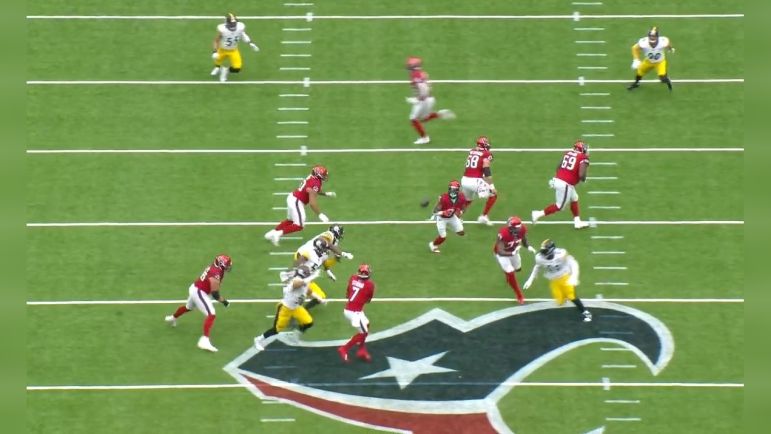On paper, it looked like the most obvious matchup in favor of the Pittsburgh Steelers. Their pass rush against the Houston Texans’ offensive line. Houston came into the game with four of its five starters injured and out of the game, started a left tackle who had never taken an NFL snap, ex-Steeler Kendrick Green at left guard, and a rookie at center. For T.J. Watt, Alex Highsmith, and a Steelers’ defense that had racked up 13 sacks entering the weekend, it looked like a free lunch.
Instead, Texans’ QB C.J. Stroud wasn’t sacked and hardly needed his jersey cleaned after a 30-6 win. How did Houston overcome such a negative-looking matchup? A couple of ways. Let’s break it down.
1. Run Game/Staying On Schedule
The Texans ran the ball well in this game, especially early, and didn’t put themselves in many third-and-long situations. Those are obvious pass situations where the Steelers’ rushers could pin their ears back and attack. Houston effectively used its perimeter run game to get the ball on the edges, making the linebackers and line run horizontally all game.
Their first run of the game was a toss right to RB Dameon Pierce, who went for 13 yards, longer than any run he had in his previous three games.
They again called a toss on the first play of their second drive for another successful gain.
And twice early in the game, they used perimeter runs with speedster rookie WR Tank Dell, who easily gained the edge and benefitted from good blocking by the Texans’ receivers and backs, who put their hand in the pile to open up lanes.
Overall, the Texans stayed out of “and long” situations. Entering the game, they averaged 7.4 yards to go on third down, 22nd in football. Against the Steelers? They needed an average of just 5.2 yards on third down, the third-best figure of any offense in Week Four. When you’re not in third and 10, you can take Watt and Highsmith out of the game.
2. Play-action
Play-action was another tool to slow the Steelers’ rushers down a beat. On their opening-drive touchdown to WR Nico Collins, Stroud faked the handoff before firing over the middle. It slowed down the Steelers’ rush, especially LB Cole Holcomb coming off the edge, and gave Stroud time to fit the ball over the middle.
And here it is again. Alex Highsmith slows down a tick with the play fake and the split-zone block coming at him, allowing Stroud to float this one to the receiver, beating Levi Wallace for a first down.
3. Screen Game
Arguably the best weapon to slow down a pass rush is the screen game. That was clearly part of the Texans’ script, using it twice on their opening drive. One would’ve been a touchdown to RB Dameon Pierce but was called back on an ineligible man downfield penalty. This one earlier in the drive was hugely successful for 27 yards. A great call against the inside linebacker blitz and watch Green, No. 50, pancake Holcomb downfield.
They hit it again in the second quarter for 11 yards to Devin Singletary.
Hit screens like this and the Steelers’ EDGE rushers start worrying about it. And it starts slowing them down mentally and physically.
4. Empty
Finally, empty is a hidden weapon to slow the Steelers down. It may look risky because there’s no additional protection for your tackles. But the Texans took a cue from the Cleveland Browns by coming out in heavy personnel groupings, 12 and 21 personnel, to keep the Steelers in their base 3-4. Then, they spread the field in empty. Often in those situations, the Steelers will walk out one of their outside linebackers to cover (twin-wide receiver sets is also a good way to get Pittsburgh to do this).
In these examples, OLB Alex Highsmith walked out to cover. That kept him away from rushing on Texans third-string left tackle Austin Deculus, a win for Houston. In the second clip, the Steelers have poor rush lane integrity and gives Stroud an easy escape lane.
Houston did all this within its first 31 plays of the game, clear evidence of its game plan and intent. Combine all of that with the normal things teams do against Watt and company — chips, slides, and tight end alignment — and the Texans didn’t let Watt and Highsmith write the headlines. Sure, they had a couple of pressures, Highsmith won clean twice on third down but it’s nothing that told the story of the game. The Texans built themselves a comfortable lead and could run the ball out in the fourth quarter, the ultimate way to mitigate Watt, Highsmith, and company.
Pittsburgh’s offense got outcoached and out-schemed. That’s been the bulk of the headlines, but the same thing happened to Mike Tomlin/Teryl Austin and the Steelers’ defense. The Texans were one step ahead, knew where they could win, knew what they had to mask, and got it done.








